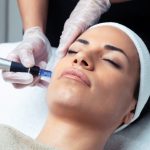If you see red, spider-like clusters around your nose or on your cheeks or chest, it is likely broken capillaries. The blemishes are not a serious medical condition, but they can be frustrating to find on your skin. In this blog, learn the causes of broken capillaries, how to prevent them and treatment options.
What is a broken capillary?
Our bodies have a network of veins that transport blood, oxygen and nutrients to our cells. The capillaries are the smallest blood vessels in the body, but when they become dilated or broken, they can be visible on the skin’s surface. These tiny, dilated blood vessels are called telangiectasias.
Broken capillaries on the face or chest are usually seen in small clusters and have a red hue. Unlike a skin rash, they are not caused by an irritant. They are harmless, but some can find them unappealing, especially when they appear around the nose or on the cheeks or chest. Broken capillaries are the smaller version of the spider veins or varicose veins you might find on your legs.
What causes broken capillaries?
Broken capillaries can affect people of any age, gender or skin type, but several factors can make you more likely to develop them. Here are the top six reasons you might develop this condition on your face or chest:
Genetics
If your biological parents or grandparents have broken capillaries, you may be prone to getting them. Some people have more fragile blood vessels than others, so you may have inherited that trait from a family member. Unfortunately, genetics can also make it more likely that you will get spider and varicose veins on the legs.
Sun damage
Excessive sun exposure damages the skin in many ways. It can weaken the walls of your blood vessels, making them more likely to dilate permanently and cause broken capillaries. The sun’s rays can also cause the blood vessels to move closer to the surface of the skin.
Rosacea
Rosacea is a chronic skin condition that can cause redness, inflammation and small bumps on your nose, cheeks and forehead. It can also make the veins around your nose or cheeks more visible and prone to broken capillaries. Managing rosacea symptoms can reduce the redness associated with this condition.
Lifestyle
Drinking alcohol causes your blood vessel to dilate, increasing your chance of developing broken capillaries. Smoking not only damages your lungs, but it can also cause inflammation in your veins that can lead to this condition.
Skin trauma
Injuries to the skin can cause broken blood vessels. Avoid harsh at-home skin treatments or picking at blemishes because they can cause broken capillaries.
Aging
As we age, our skin becomes thinner and weaker, making it more prone to trauma. We lose collagen, which makes our skin strong and elastic. Loss of collagen can make veins more visible on the surface of the skin.
What are my treatment options?
Several treatment options are available to treat broken capillaries or diminish their appearance. If you are concerned about this condition, make an appointment with a board-certified dermatologist for a plan that may include one of the following treatments.
- Laser treatments can reduce or remove smaller areas of broken veins. Lasers target the veins with waves of energy that stop the blood flow, which causes the capillaries to fade gradually. You may need more than one treatment to see results.
- Intense pulsed light (IPL) therapy, also known as a photo facial, uses broad-spectrum light to target the capillaries and other skin imperfections. The light emitted from light heats the capillaries to destroy them. After a few days, the veins are absorbed into the skin. You may need more than one treatment depending on the severity of the condition.
- Topical creams cannot eliminate broken capillaries but can help reduce their appearance by plumping the skin. Creams with vitamin K can reduce the redness, and a product with retinol can stimulate collagen. Talk to your skin care professional for recommendations.
- Sclerotherapy is used for varicose veins and larger spider veins in the legs. A dermatologist will inject a solution directly into the broken blood vessel, which causes it to collapse and be reabsorbed by the body.
How do I prevent broken capillaries?
While broken capillaries may not be entirely preventable, there are steps you can take to reduce your risk of developing them. Here are a few tips to keep in mind:
- Wear broad-spectrum sunscreen to protect your skin from UVA and UVB rays. Read our tips on sunscreen best practices to see if you are applying it correctly.
- Avoid smoking and excessive alcohol consumption.
- Drink water to keep your cells hydrated and promote skin elasticity.
- Manage your rosacea symptoms by avoiding triggers that cause inflammation.
- Avoid squeezing skin blemishes like pimples, whiteheads or blackheads.
- Use lukewarm water when washing your face. Hot and cold water can cause veins to swell.
- Follow a regular skincare regime.
Skin treatments in Columbia
Broken capillaries can be frustrating to deal with, but fortunately, several treatment options are available. At Columbia Skin Clinic, we can help you determine the best course of treatment for your individual needs. If you’re struggling with broken capillaries, don’t hesitate to schedule a consultation with us today.






